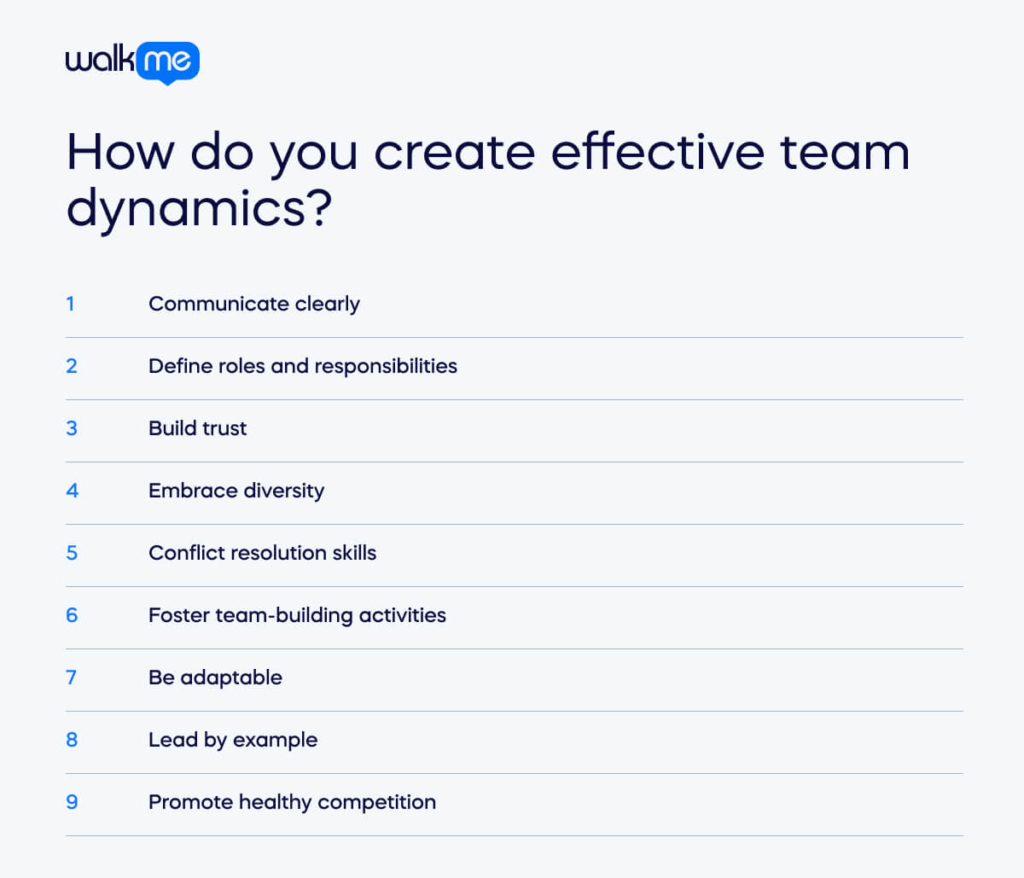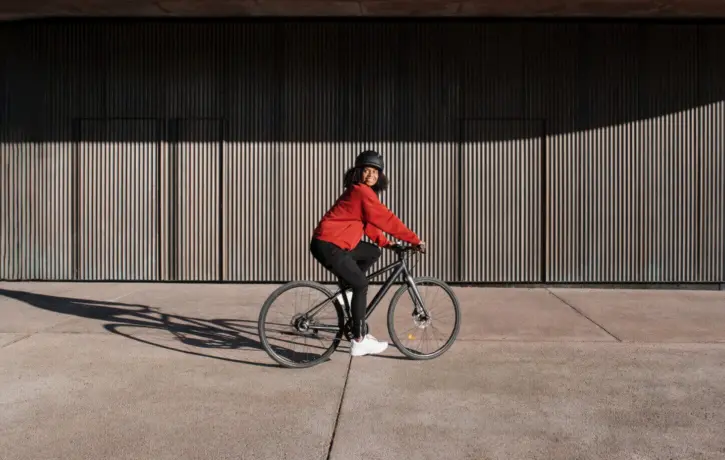Team dynamics are the forces at play that influence how teams function. These dynamics include formal groups, where a leader builds teams for a specific purpose, or informal groups, where individuals come together temporarily for a looser purpose, like a regular coffee break.
These dynamics significantly impact team function, and ignoring them can have negative consequences, such as failed outcomes, or even negatively affect employee retention.

This article explores examples of effective team dynamics to help you understand your teams. It also explains how to create your team dynamics and their influencing factors.
Once you have read through this article, you will be an expert in how teams work and how to make them collaborative, healthy, and able to complete goals for faster project ROI, higher employee productivity, and a positive organizational culture.
Examples of effective team dynamics
We all learn best by example. This philosophy is what we used to compile this list of the best examples of effective team dynamics. Read each example, apply the lessons to the teams in your digital workplace, and see what you can implement to draw from the strengths of each.
The Apollo 11 moon landing team
Remember “That’s one small step for man. One giant leap for mankind” when Neil Armstrong set foot on the moon? Behind that historic moment was a team of brilliant minds at NASA. What made this team dynamic genuinely effective?
We know a lot about these challenges from the experiences and stories of the crews on the international space station. The 60 expeditions featuring multi-national and mixed-gender crews have produced a much more diverse collection of astronauts than in the Apollo era.
Each team member, from the astronauts to the engineers, had a clearly defined role. They communicated seamlessly and collaborated to solve complex problems in real-time. This unified effort propelled them to achieve what was once thought impossible.
There is also a team-building game inspired by the NASA team responsible for the moon landing.
What can we learn from this example?
NASA teaches us a lot from the stars, which we can relate to here on Earth.
NASA offers the following lessons about effective team dynamics:
- Idea exchange: Teams thrive on collaboration and idea exchange, fostering improved decision-making and innovation. For instance, in enterprise software development, regular brainstorming sessions fuel the generation of new features and enhancements.
- Collaboration breeds innovation: Teams craft more innovative products by amplifying each other’s contributions. This synergy applies to all teams; whether in tech or elsewhere, a culture of free idea exchange leads to exponential innovation.
- Diversity is crucial to fresh outlooks: Like cooking, where diverse spices enhance a dish, collective input elevates outcomes. Remember the potency of collaboration when working in teams; remarkable achievements are within reach.
Pixar’s creative powerhouse
Many individuals argue that good ideas outweigh good people in value and rarity. Ed Catmull, the former head of Pixar and Disney Animation Studios, vehemently opposed this notion.
He believes it stems from a flawed perception of creativity, which overemphasizes the initial idea’s significance in product development and misinterprets how to manage risks in innovation.
Creativity thrives through diverse teams collaboratively tackling unforeseeable challenges in filmmaking and complex product development.
Catmull advocates for three key strategies: empowering project leaders with creative authority, fostering a culture of sharing and peer support, and breaking down disciplinary barriers.
Catmull emphasizes constant self-assessment, open communication, and challenging assumptions to sustain Pixar’s success amidst industry turbulence.
He underscores the importance of leadership in upholding organizational values, personally engaging with new hires to share Pixar’s past mistakes, and ensuring a culture of continual improvement.
What can we learn from this example?
We can learn a lot about team dynamics from Pixar.
Pixar team dynamics remind us of these crucial points:
- Self-assessment: Constantly question your motives for particular decisions as individuals and groups. This approach can help ensure ideas are practical and decided on by the group.
- Open communication: Open communication is the core of effective team dynamics. It encourages everyone to share ideas in a safe and nurturing environment. This environment promotes respect and a group approach to finding the best ideas for every solution.
- Challenging assumptions: A positive team dynamic promotes constant challenge of assumptions. Challenging assumptions leads to innovation, which lets you outcompete your peers and creates successful enterprises by generating new ideas to satisfy customers and maintain the perception of a fresh, exciting organization.
The 1992 U.S. Men’s Olympic Basketball “Dream Team”
The media often refers to the 1992 U.S. Olympic Men’s Basketball Team as the greatest basketball squad ever assembled.
With 11 out of the 12 players eventually inducted into the Naismith Memorial Basketball Hall of Fame, their legacy endures.
This team marked the debut of professional players in the Olympics, showcasing their prowess at the Barcelona 1992 Games. They won each match by over 30 points, captivating audiences with their dominance.
Led by Charles Barkley, who averaged 18 points per game, and Michael Jordan, who has 14.9, alongside Karl Malone, Chris Mullin, and Clyde Drexler, the team showcased unparalleled talent.
Notably, Coach Chuck Daly’s trust in his team was so profound that he refrained from calling a single timeout throughout the tournament.
The team’s goal was crystal clear: bring home the gold. Ego took a back seat to team success. They trusted each other’s skills and played together harmoniously, showcasing the power of a shared objective in fostering teamwork.
What can we learn from this example?
We can unpack a lot of learning from the 1992 Dream Team.
The dynamics of the Dream Team remind us of these crucial points about team dynamics:
- Strong leadership can be a game-changer: The 1992 Dream Team included some of the most talented athletes the US has ever seen. But without strong leadership, they would have failed. Always ensure the right team members are paired with the best leader to coordinate their talents.
- Play to your strengths: The members of the Dream Team had different strengths in different areas due to their various roles in the team. Playing to their strengths won them several victories. Support your team members in playing to their strengths for successful outcomes.
- Investment in talent pays off: The 1992 Dream Team consisted of the greatest players available in history. They wouldn’t have come cheap, but they were worth it. Don’t scrimp on the best talent you can find; it will only fail. Invest in the best talent you can find today to reap the rewards come the project deadline.
The Emergency Room (ER) team
In the high-stakes environment of an emergency room (ER), effective team dynamics are paramount, often determining life-or-death outcomes.
Teamwork within emergency medicine cultivates a collaborative care model, benefiting patients in numerous ways.
By amalgamating their expertise and viewpoints, healthcare professionals construct comprehensive treatment strategies.
Timely and precise communication among team members ensures swift sharing of critical information, expediting decision-making and interventions. This cooperative approach elevates patient outcomes by facilitating optimal, evidence-based care delivery.
Clear and concise communication is the cornerstone of effective teamwork in emergency medicine. Accurate information exchange is imperative in time-sensitive scenarios, where every moment counts.
Team members must convey vital details succinctly and accurately, minimizing the risk of errors or misinterpretations. Such transparent communication streamlines patient care and bolsters team cohesion, fostering a collaborative and error-reducing environment.
What can we learn from this example?
We can learn a lot from ER teams.
The dynamics of ER teams across the US remind us of these crucial points about team dynamics:
- Clear communication: Clear communication for medical procedures is essential in emergency healthcare to avoid loss of life. The stakes may not be as high in enterprise teams, but other resources, such as time and money, are at stake. Ensure clear communication to secure positive project outcomes.
- Quick decision-making: ER requires specialists to make fast decisions and use their skills where necessary. This point is the same in other organizations, where specialist knowledge must be present and used to meet deadlines and get results quickly and accurately.
- Consistency under pressure: Time is always running out for ER teams, and every second can bring tragedy. Your team’s situation is similar. In the digital age, competitors are always racing to outcompete one another, which pressures every team to progress quickly and survive. You must be consistent under pressure to avoid mistakes, make the right decisions, and ensure success.
These examples don’t appear at first glance to be relevant to enterprise settings. However, the lessons below clarify that enterprise teams can learn from any team, regardless of context. Reflect on these examples to take the relevant aspects to your teams and improve your dynamics for better outcomes.
How do you create effective team dynamics?

Once you understand effective team dynamics, you can try to implement them in your own teams.
While supporting individuals to collaborate in teams can be challenging, a systemic approach can increase the chances of success. The first approach is to promote clear communication.
Communicate clearly
Imagine playing a game of telephone where messages get distorted with each pass. That’s what happens when communication within a team isn’t crystal clear. To foster great dynamics, ensure every team member understands their roles, goals, and expectations. Encourage open dialogue, active listening, and provide feedback regularly.
Define roles and responsibilities
Have you ever watched a soccer match where everyone chases the ball without a plan? It’s chaos, right? The same goes for teams without defined roles.
Clearly outline each team member’s responsibilities so they know expectations. This clarity minimizes confusion and helps everyone play their part effectively. You can also make roles and responsibilities part of employee training to ensure new and existing employees know the expectations for their roles.
Build trust
Trust forms the foundation of high-performing teams, akin to a delicate plant requiring constant nurturing.
Reliability, keeping promises, and offering support to teammates cultivate this trust. As trust blossoms, collaboration flourishes, fostering an environment where ideas are freely shared and individuals feel valued and respected.
Embrace diversity
Incorporating diverse backgrounds and skills enhances team resilience and effectiveness. Encouraging varied perspectives stimulates creativity and innovation, offering fresh insights that can resolve challenges and drive project success.
Embracing diversity enriches problem-solving and promotes inclusivity, making each team member feel heard and valued.
Conflict resolution skills
Conflicts are inevitable in any team setting, but addressing them constructively strengthens relationships and fosters growth. Implementing conflict resolution processes encourages open dialogue, compromise, and learning from disagreements.
By confronting conflicts directly and respectfully, teams can overcome obstacles and emerge more robust, with enhanced communication and problem-solving abilities.
Foster team-building activities
Engaging in team-building exercises outside the workplace nurtures camaraderie and cohesion. Organizing fun outings or activities promotes bonding among team members, fostering mutual understanding and trust.
These shared experiences create a supportive environment where individuals feel connected and motivated to collaborate effectively towards shared goals.
Be adaptable
Adaptability is essential in navigating the dynamic business landscape. Encouraging flexibility within the team fosters resilience and agility, enabling swift responses to changing circumstances.
Embracing new ideas and approaches and being open to course corrections empowers teams to innovate and thrive amidst uncertainty, ensuring continued success in achieving objectives.
Lead by example
Leadership sets the tone for team dynamics and influences behaviors and attitudes. Demonstrating punctuality, dedication, and positivity inspires others to emulate them.
Using the best team dynamics is essential during transformational leadership because a digital transformation requires quick thinking and hitting deadlines to ensure no waste and the completion of shared goals.
Whether in a formal leadership role or not, leading by example fosters a culture of accountability, respect, and continuous improvement, driving team members to strive for excellence and collaborate effectively towards shared goals.
Promote healthy competition
Balanced competition within the team can spur innovation, creativity, and motivation. By setting achievable goals and fostering friendly rivalry, teams harness their competitive spirit to drive performance and achieve excellence.
However, it’s crucial to maintain a supportive environment where competition remains constructive. This approach will promote collaboration and collective success while avoiding negative dynamics hindering teamwork.
Consider these approaches. Do you practice them already when trying to ensure effective team dynamics in your teams?
“Following these approaches is crucial to ensure you’re supporting teams in cultivating the most collaborative environments with healthy cultures. Doing so allows them to operate optimally and encourages innovation and success in every team project.
Align AI’s strengths with team dynamics for positive outcomes
It would be hard to talk about team dynamics without mentioning the impact of unforeseeable factors like generative AI.
Advancements in artificial intelligence (AI) like ChatGPT suggest machines are increasingly assuming tasks once managed by individuals. Yet, collaborative work remains challenging to automate.
Proficiency in teamwork and comprehension of team dynamics emerge as pivotal workplace skills, potentially safeguarding job security.
Integrating AI in team dynamics enhances collaboration and productivity. AI-powered tools can streamline communication, task allocation, and project management, facilitating smoother workflows.
Additionally, AI algorithms can analyze team interactions and provide insights to improve decision-making and optimize performance.
By leveraging AI, teams can adapt more effectively to challenges, capitalize on opportunities, and achieve success.
Hence, while AI reshapes individual tasks, the essence of effective teamwork remains irreplaceable. Therefore, you can use AI alongside existing team processes to ensure effective team dynamics in the age of AI.


